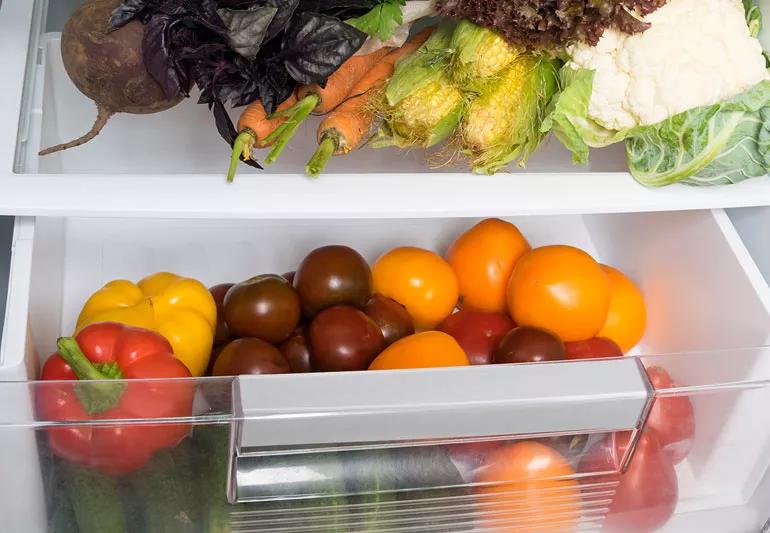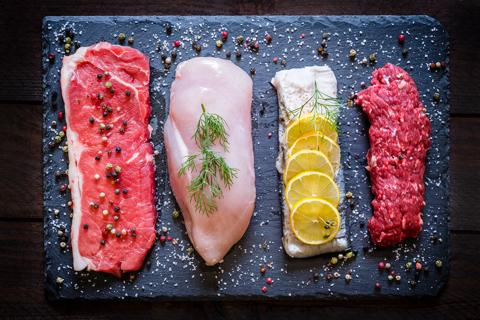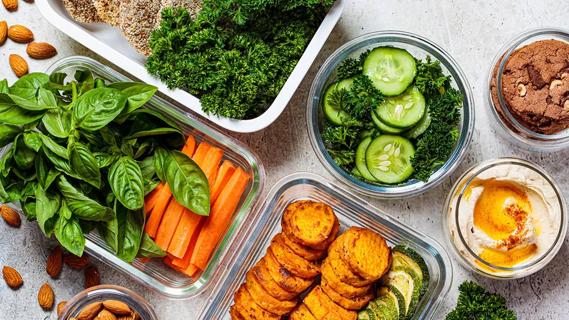Here’s how to put together meals packed with health benefits

You’ve probably been told since you were a kid that eating healthy is important. That means keeping a diet that’s rich in fruits and vegetables, whole grains, lean meat and low-fat dairy.
Advertisement
Cleveland Clinic is a non-profit academic medical center. Advertising on our site helps support our mission. We do not endorse non-Cleveland Clinic products or services. Policy
A healthy diet might look different from what you think, though. It’s not settling on a rotation of meals and snacks you like and then eating those day in, day out. Instead, it’s keeping a wide variety of nutrient-packed foods in your cooking rotation.
“Focus on food groups that are packed with nutrition, such as beans or vegetables,” says dietitian Julia Zumpano, RD, LD. “Variety is key. For instance, don’t limit yourself to eating the same few veggies; instead, challenge yourself to choose a different vegetable every day. You don’t want to eat the same specific foods every day.”
You might wonder why eating a variety of healthy foods is important. After all, if something is healthy, isn’t it fine to eat it every day?
While that can certainly be true — for example, a nutrient-packed fruit like blueberries is fine for a daily snack — there are very good reasons for mixing things up.
For example, Zumpano notes that eating the same exact things on a daily basis means you’re likely missing out on important vitamins and minerals.
“You get more nutrients from eating a variety of foods,” she says, and notes that a good rule of thumb is trying to eat a food of “each color of the rainbow. These tend to have similar nutrient properties.” For example, foods rich in vitamin C are yellow, orange and red.
Advertisement
Changing up your diet can also help you stick to eating healthy. “Who wants to eat the same foods every day? That’s so boring, right?” Zumpano says. “And when you’re bored, that’s when your diet goes by the wayside.”
To follow a balanced diet, you want to eat a variety of foods from the following groups on a regular basis. As an added bonus, these foods are also part of a heart-healthy diet.
Your parents were right: Eating your veggies is key to a healthy diet. In fact, you can’t really go wrong piling on the plants at every meal.
Leafy green vegetables are an especially healthy choice. Spinach, for example, gives you vitamins K and A, folate, magnesium, iron and fiber.
“I keep a large container of organic spinach, arugula, mixed baby greens or spring mix in my fridge at all times to add to soups, salads, rice, pasta, smoothies and protein shakes,” Zumpano notes.
However, don’t be like “Popeye” and munch on spinach 24-7. Mix things up. “You’re completely restricting yourself by just eating spinach every day,” Zumpano cautions. “What about all the other green vegetables? I also stock my freezer with frozen chopped kale or greens to use in a pinch.”
Fruits are also an anchor of a healthy diet. But not all fruits are created equal. For example, mangoes are high in sugar, so you should share a mango or limit to half a mango.
Berries are an excellent choice for a meal or a snack. “Berries are low in sugar, compared to other fruits, and quite versatile,” Zumpano says. They’re rich in antioxidants — as noted, blueberries especially — as well as vitamins and minerals. Blackberries, meanwhile, are full of vitamin C, folate, manganese, potassium and fiber. Add berries to cooked grains and dry whole-grain cereal, yogurt, smoothies and salads.
Protein is crucial to building strong muscles and bones, among other things. Not all kinds of protein give you the same health benefits, though.
For example, animal protein contains higher amounts of cholesterol and saturated fat — both of which can lead to an increased risk of developing heart disease.
Plant-based proteins, in contrast, give you nutritious benefits without many of the downsides.
Soybeans such as edamame are a great way to get protein. The tiny green bean is a good source of vitamin C, iron, potassium and fiber. You can eat edamame pureed into a dip or in its raw form.
Legumes are a plant, or the seed of a plant. Legumes include dried beans and lentils. Peanuts are also technically legumes because of their shell. However, from a nutrition standpoint, we categorize peanuts as a nut due to their higher fat content.
Advertisement
The legume known as chickpeas is what’s known as a complete protein — it contains all nine essential amino acids — and is also a great source of fiber.
Dried beans and lentils are another great legume option to pack on the protein. An easy meat substitute when cooked — try them mashed into a burger or simmered in chili — they contain B vitamins, folate, soluble fiber, and a variety of vitamins and minerals.
Starches, or carbohydrates, provide energy that keeps your body going. Eating the right kind of carbs is important, however.
Sweet potatoes and regular potatoes have comparable nutritional value. However, sweet potatoes are full of beta-carotene, calcium and vitamin A, and are surprisingly lower in carbs and calories.
Quinoa is a seed from a plant that has the properties — and health benefits — of whole grain. Not only is it a complete protein and full of fiber, but it’s a good source of zinc and phosphorus. Try quinoa as a meatless meal or side, with veggies mixed in for an added boost.
Fat is a necessary component of a healthy diet. As with protein, however, the kind of fat you consume matters. Consuming too much saturated fat, for example, is known to be a risk factor for developing heart disease and diabetes.
Advertisement
Omega-3s are unsaturated fats that are crucial for heart, brain and eye health. Fish, such as salmon and tuna, are full of this healthy fat, although experts warn to be careful not to overdo it on the seafood. Certain kinds of fish are high in mercury, which is unsafe for children and people who are pregnant and breastfeeding. Zumpano recommends having 4 ounces of omega-3 fatty fish twice a week.
Squirrels have it right — nuts make a great snack. Walnuts, for example, are rich in plant-based omega-3 fatty acids, as well as copper, protein and fiber.
Seeds aren’t just for the birds. Chia seeds and flax seeds are both great sources of the plant form of omega-3, which is called alpha-linolenic acid (ALA). These seeds make a tasty addition to salads and smoothies. Add 2 tablespoons of ground flaxseed daily to cooked oatmeal, yogurt and smoothies.
Not all cooking oils are good for you. In fact, many are super high in unhealthy fats. Extra virgin olive oil is an excellent choice for dressings or low-heat cooking. Avocado oil, however, can be great for stir-fries and other higher-heat cooking.
Eating healthy doesn’t have to be boring. Putting together a robust rotation of meals, with a variety of healthy ingredients, can lead to beautiful breakfasts and delicious dinners alike.
Advertisement
Learn more about our editorial process.
Advertisement

With a focus on internal cues for hunger and fullness, this eating style may revolutionize your relationship with food

Review the ingredients, watch for sugar and fat, and choose one with the right amount of protein for your needs

A typical recommended balanced diet is half fruits and veggies, a quarter protein and a quarter grains

Foods high in protein, fiber and water can help keep hunger at bay

This quirky food trend is harmless, as long as you’re getting enough protein, fiber and healthy fats

This vital nutrient helps your brain and body in many ways — and most of us need more of it

Wrapped or sandwiched, try to choose fillings and condiments that are minimally processed, low in saturated fat and high in fiber

Set yourself up for success by carefully choosing your recipes, storage containers and prepping day

Babies can get congested easily, but you can calm their cough by keeping them hydrated, using nasal drops and running a humidifier

Weight loss may cause loose, sagging skin and muscle loss to your rear

Several conditions, like vitiligo and fungal infection, can cause a loss of pigmentation, leading to white spots or patches on your skin